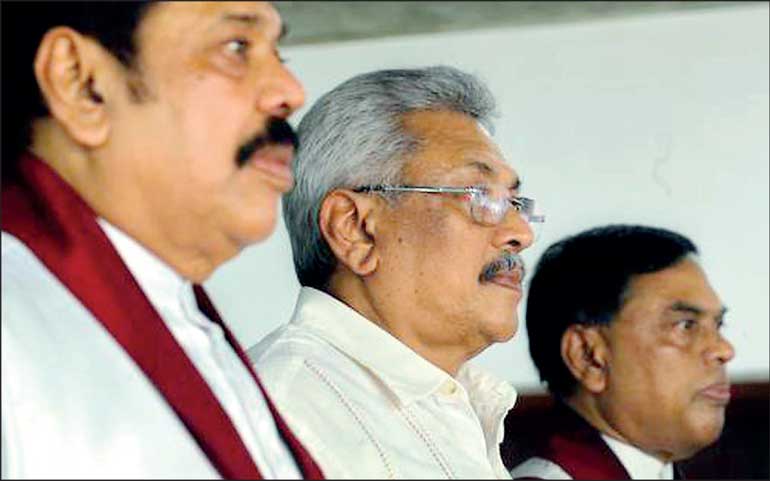Saturday Dec 27, 2025
Saturday Dec 27, 2025
Saturday, 23 April 2022 00:00 - - {{hitsCtrl.values.hits}}

Public debt does have a long history in this country, and there are ill-conceived attempts to hide the true facts of public debt. The result of recessions, banking panic and financial crisis have pushed various interested parties to question the benefits of debt and the impact of excessive debt and default, which leads to the question of an optimal debt quantum
 Public debt is a hot topic in Sri Lanka. Government borrowings of this country in the past was to bridge Budget Deficit due to shortfall in tax revenue or meet anticipated expenditure. In the recent past, much borrowing was done for necessary as well as not immediately necessary infrastructure development considered as long-term investments such as ports, airports that were assumed to accelerate economic growth.
Public debt is a hot topic in Sri Lanka. Government borrowings of this country in the past was to bridge Budget Deficit due to shortfall in tax revenue or meet anticipated expenditure. In the recent past, much borrowing was done for necessary as well as not immediately necessary infrastructure development considered as long-term investments such as ports, airports that were assumed to accelerate economic growth.
The Government is forced to borrow to meet the deficit in Government budget such as an Over Sized Public Service, Non-Performing State Owned Enterprises, Pension Payments, as well as sale of Imported Consumables such as fuel below imported cost to maintain a welfare state.
Most public utilities are billed below cost due to political pressure to support the public to meet social demands or the reluctance to increase taxes for fear of political consequences. Loss incurred by subsidised corporations was over Rs. 100 billion last year. All citizens subscribe for this. We are now in a local and international debt trap by short-sighted investment and management by the Government.
The Government can borrow at low interest rates from many global funding institutions based on project proposals as long-term investments at low interest rates with grace periods.
Investors consider Government bonds as a safe haven and thus, it can be an attractive source of revenue instead of taxation. Overall, public debt can have significant implications on the economy and society. Governments, like all financial institutions, need to manage their debt to facilitate growth.
Therefore, it is very evident that public debt and public debt management is a significant area of research as it has several stakeholders such as economists, statisticians, analysts, investors, accountants, politicians and many more.
This is because history has demonstrated that excessive debt can have catastrophic consequences such as economic recessions, debt overhangs, banking system collapses, exchange rate crises and inflationary explosions such as the recent debt crisis Sri Lanka is facing.
Public debt does have a long history in this country, and there are ill-conceived attempts to hide the true facts of public debt. The result of recessions, banking panic and financial crisis have pushed various interested parties to question the benefits of debt and the impact of excessive debt and default, which leads to the question of an optimal debt quantum.
For example, one of the critical discussions observed in economic and finance literature is the relationship between debt and economic growth and the possibility of an optimal debt to GDP. Furthermore, economic literature looks into the ideal public policy responses as against crises and sustainability. Similarly, accounting research focuses on the issues of measurement and reporting of the public sector to improve accountability and support decision making.
The principal responsibility amongst regulatory bodies such as World Bank (WB), IMF, Japan Bank for International Cooperation (JBIC), and International Finance Corporation (IFC) is to maintain stability in the financial system and healthy sovereign borrowers are the bedrock of that system. Over the last decade, public debt has reached new highs.
‘Hidden debts’
One of the worrying concerns amongst regulators monitoring Sri Lanka is the rise in debt driven by ‘hidden debts’, whilst amidst a changing creditor and instrument landscape. These hidden debts can pertain to a combination of, off-balance sheet borrowing, weak public debt recording and reporting, printing of money and poor governance as well as non-economists being involved in governance and debt control as a result of political bungling.
In this context, improvements in reporting and comparability of debt measures are vital, so it can soften the lending conditions by reducing ‘debt surprises’ and overall support the proper assessment of public finance sustainability by lenders. Debt reporting plays an important role in governance.
In this country, most State accounts are not up to date and audits are not done or are over 12 months late in State organisations and they are not published for public knowledge. Transparency of accounting formats are not universal.
Debt in this country is denoted as Foreign Borrowings. Debt data may consist of debt securities and loans. In this country the method of valuation is not explicitly stated, even though different methods of valuation can create significant differences. Consolidation, which involves removing intra-government obligations, can have an impact on debt figures.
If debt is reported on a cash basis, it will exclude significant arrears or non-cash obligations. Therefore, the definition of debt and how debt is reported matters significantly. This dissertation offers insight into the challenges of measuring debt by examining the two main reporting systems. Statistical Vs Accounting.
This will be analysed further by assessing what kind of liabilities are and must be included, to which public sector entities belong to and how they are valued. Given these dimensions and challenges, public debt can be defined in many ways. It is therefore vital to obtain clarity about the definitions and purpose when using debt indicators.
Additionally, should the Government provide one standardised headline debt indicator? This could support greater transparency and comparability with international figures. Is the Government Debt of this country based on a universal debt measure? Regardless, this view of having a one standardised headline debt indicator is a must.
The crisis that Sri Lanka is facing now has to be looked at statistically and financially. Options available will be to restructure all foreign commercial borrowings. Government can borrow at low interest rates from many global funding institutions based on project proposals as long-term investments at low interest rates with grace periods with help of IMF, ADB, JBIC, IFC, WB and others.
The way out of public debt for welfare has to be met with increased taxes or removal of subsidies. Government is moving the low-income public to a “low income trap” by providing Samurdhi, handouts etc. This year approximately 500,000 families have been moved down to the low income group.
The objective of the Government should be to move No Income Groups to Low Income Groups and Low Income Groups to Middle Income Groups by supporting and inciting private sector to increase employment opportunity, greater agriculture performance and farming.
India and China are good examples in moving No Income to Low income to Middle Income Groups. Bangladesh has been able to move its Poverty Rate down to 11% in 2021 and is expected to hit below 10% in 2022 in spite of COVID, as stated by the World Bank. Our politicians work the other way by increasing welfare recipients; “Koheda Yanne Malle Pol”.
A major role can be played by increasing private public transport and improved non-subsidised railway service which is used only by 7% of the traveling public. Efficiency of public utilities must be measured by output per employee vs cost of employment as a target for efficiency. Private Vs Public organisations.
A good example is Indian Oil Corporation, a State corporation of India in Sri Lanka. They make profit whereas Ceylon Petroleum Corporation Operates at a loss? Cost of employment is very high at CPC as well and there being a political indifference in management.
Still imports are greater than exports in spite of ban on imports. Debt to GDP is 111%. Value of the rupee has dropped by approximately 32%. Banks are on Rating Watch Negatives. Bilateral debt has increased due to political bungling.
Another shortcut method is to maintain two sets of books. Move all Government and State organisation outstanding debt between State organisations such as Debt to Petroleum Corporation by CEB/Railway/SLTB/SriLankan off the books from 31 March and operate on a cash basis.
Thereby deleting State responsibility for settlement of dues; “Robbing Peter to Pay Paul”. This will result in loss-making State organisation responsible for payments. Ministries and Heads of Departments will have to think as private sector non-subsidised organisations to work on a cost vs output basis.
We need to bail out of the current crisis by having immediate, short-term, long-term plans. It may be unpopular but “Country and People have to survive for the next generation”. Even with a change of Government, Central Bank Governor and Secretary Ministry of Finance should not be moved until the country gets out of crisis assuming their plans work within the next four to six months.
Professionals in ministries must be made to undertake responsibility. Politicians are interested in winning the next election at the cost of people. Country has to survive and people have to live over and above politics.
The smartest move to bail out corrupt debt-burdened countries is being done by India which is Aid for Trade. If not, 30% of the bailout package will be pocketed by corrupt politicians as what has happened to this country for the past three decades.